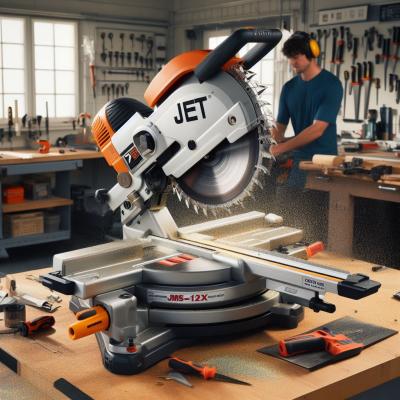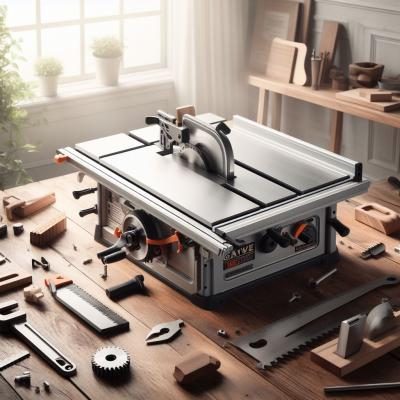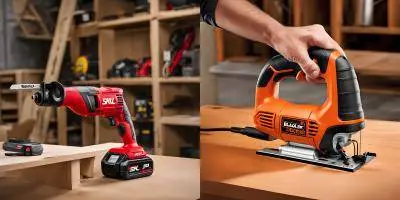Mastering the Woodworking Arena: Understanding the Battle between Miter Saw vs Table Saw
When embarking on a woodworking project, choosing the right tool can make all the difference. Both miter (or mitre) saws and table saws have their unique advantages, tailored for specific tasks. Understanding their capabilities and limitations ensures precision and efficiency in any craft. This article provides insights to help you decide which saw best meets your needs.
I. Introduction
A. Significance of Choosing the Right Saw
Selecting the proper saw for your woodworking projects is more than just a matter of convenience. The right tool can significantly impact the quality of your work, ensuring precise cuts and an overall more polished result. It also influences your work’s speed, safety, and efficiency.
B. Brief Overview of Both Saws
Miter saws and table saws are two of the most commonly used tools in woodwork. While they have some similarities, they cater to different needs and have distinct advantages. This guide will delve into the intricacies of both to help you make an informed choice.
II. Basics of Miter Saws

A. Definition and Design Features
A miter saw is specifically designed to make accurate crosscuts and miters in a workpiece. It consists of a blade mounted on a swing arm that pivots left or right to produce angled cuts. Some advanced versions can tilt to create bevel cuts.
B. Main Purposes and Advantages
Miter saws excel in tasks requiring precise angle cuts. They are efficient for cutting moldings, window casings, and other tasks where accuracy is paramount. Their fixed blade ensures consistency, and the adjustable miter index allows for a wide range of angle cuts.
C. Situations Where Miter Saws Shine
For frame-making, crown moldings, or any project that requires a precise angle, a miter saw is your best friend. Its design allows for quick adjustments and can handle different materials, making it a versatile tool for various projects.
III. Fundamentals of Table Saws

A. Description and Key Characteristics
Table saws are stationary tools with a circular blade protruding from a table’s surface. The height and angle of the blade can be adjusted to control the depth and angle of the cut. A fence guides the workpiece, ensuring straight cuts.
B. Primary Uses and Benefits
Table saws are the go-to for making long straight cuts or rip cuts. They can handle larger pieces of wood, making them ideal for tasks like cutting plywood sheets or long lumber pieces. Their stationary nature also allows for consistent, repeated cuts.
C. Ideal Projects for Table Saws
Building cabinets, large furniture, or any task that requires cutting large panels or boards, table saws are indispensable. They provide stability and precision, especially for long, straight cuts.
IV. In-depth Comparison: Miter Saw vs Table Saw
A. Accuracy and Precision in Cuts
While both saws offer precision, miter saws have a slight edge when it comes to angled cuts. Table saws, on the other hand, provide unparalleled accuracy for long, straight cuts.
B. Versatility in Woodworking Tasks
Miter saws are masters of angles and precision crosscuts, while table saws offer more versatility for a variety of straight cuts, from narrow rips to wide-sheet cuts.
C. Safety Precautions and Measures
Both tools demand respect and safety precautions. Miter saws, being more compact, have fewer exposed parts, reducing certain risks. Table saws, given their exposed blade and large work area, require additional vigilance.
D. Investment: Cost, Maintenance, and Durability
Cost varies by brand and features, but generally, miter saws are more affordable. However, in terms of durability and maintenance, both saws, if well-maintained, can last for years.
V. User Experience and Expert Recommendations
A. What Beginners Should Know
Starting in woodworking can be overwhelming. For beginners, understanding the fundamental uses of each saw is crucial. While miter saws are more user-friendly, table saws demand a steeper learning curve but offer broader applications.
B. Tips for Professionals
Even seasoned woodworkers can benefit from refreshing their knowledge. Investing in quality blades, regular maintenance, and understanding the latest advancements in saw technology can elevate the quality of work.
C. Feedback from Seasoned Woodworkers
Many experts emphasize the importance of understanding the project’s needs. While both saws are valuable, choosing the right one for the task can significantly affect the outcome. Some professionals even recommend having both in a workshop for maximum versatility.
VII. FAQs
Q: Which is better: a table saw or a miter saw?
A: It depends on the specific task. For versatile, straight, long cuts, a table saw excels. For precision angled and crosscuts, a miter saw is superior.
Q: Can a miter saw be used as a table saw?
A: Not really. While both are powerful cutting tools, they serve different functions. A miter saw is primarily for crosscuts and angles, whereas a table saw is designed for ripping long boards and sheets.
Q: What are the disadvantages of a miter saw?
A: Miter saws are limited to the width they can cut, typically not suited for ripping long boards, and may not be as versatile for larger woodworking projects.
Q: What are the disadvantages of a table saw?
A: Table saws can be bulkier, require more space, and might not offer the precision in angled cuts that a miter saw can deliver.
Q: Can a table saw achieve the precision of a miter saw for angled cuts?
A: While table saws can make angled cuts with a miter gauge, for precise and repetitive angled cuts, a miter saw is usually more accurate.
Q: Which is more dangerous: a miter saw, or table saw?
A: Both tools, if not used properly, can be dangerous. However, table saws often account for more workshop injuries due to kickback and the exposure of the blade.
Q: Do I need both a table saw and a miter saw in my workshop?
A: For a well-rounded workshop and the ability to tackle various projects, having both tools is beneficial. However, it depends on the specific tasks you plan to undertake.
VIII. Conclusion
A. Making the Right Choice for Your Needs
The battle between miter saws and table saws isn’t about superiority but suitability. Each tool has been designed with specific tasks in mind. When deciding between a miter saw and a table saw, it’s essential to evaluate the kind of work you’ll be doing most frequently. If precision-angled cuts are your primary need, the miter saw is your ally. Conversely, if you find yourself working with larger pieces of lumber and require straight, long cuts, then the table saw is indispensable.
B. Investing in Long-Term Usability and Durability
Durability and usability are not just about the initial purchase but about how the tool will serve you over the years. Quality tools might come with a higher price tag, but they pay off in the long run. When investing in either a miter saw or a table saw, consider the tool’s build quality, brand reputation, and available warranties. Remember, a good tool is not just about performance but also about safety, so never compromise on these features.
C. Final Recommendations
While both the miter saw and table saw have their merits, the best approach for a comprehensive workshop is to consider having both, budget permitting. However, if you have to prioritize, align your choice with the projects you’ll undertake most often. Always prioritize safety, invest in quality blades, and ensure regular maintenance. With the right tool in hand and the knowledge to use it effectively, your woodworking journey will be both rewarding and efficient.
IX. Suggested Readings
Woodworking is a craft that spans centuries, and to further your knowledge, diving deep into the world of books can be an enriching experience. Here are some noteworthy reads that every woodworker, novice or expert, should consider:
- “The Essential Woodworker” by Robert Wearing: A comprehensive guide to using hand tools for woodworking.
- “The Table Saw Book” by Kelly Mehler: Dive into the intricate world of table saws, their uses, safety, and techniques.
- “The Complete Manual of Woodworking” by Albert Jackson: An in-depth look at woodworking techniques, tools, and materials.
- “The Woodworker’s Bible” by Percy Blandford: A classic tome that covers everything from tools, techniques, and projects.
- “The Miter Saw Fundamentals” by Chris Marshall: A specialized book focusing on miter saw techniques, tips, and safety.
These books offer a blend of traditional and modern techniques, ensuring woodworkers have a well-rounded understanding of their craft. Whether you’re starting your woodworking journey or looking to refine your skills, these reads are a worthy addition to your library.







